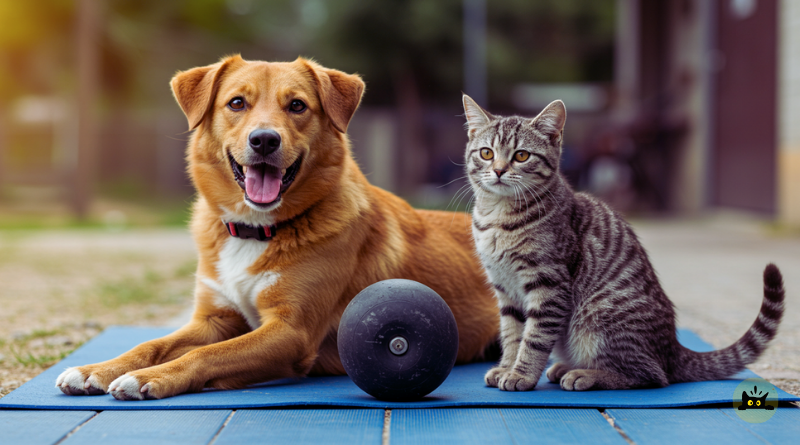Helping a pet lose extra weight can seem like a big task. A simple pet weight loss plan using small meal changes, added playtime, and progress tracking can make a huge difference. Your dog or cat will feel happier, more playful, and more comfortable. This guide walks you through easy steps you can start today, using tips from top pet experts.
Why Your Pet Weight Loss Plan Matters
Carrying extra weight puts extra pressure on your pet’s joints, heart, and organs. Pets that weigh too much often develop joint pain, breathing trouble, and hormone imbalances. Even a small amount of weight loss five percent of body weight can ease joint stiffness and give your pet more energy (AAHA). A healthy weight also cuts the risk of diabetes and heart strain, helping your companion live a longer, more playful life.
How to Tell if Your Pet Needs to Lose Weight
You don’t need fancy tools to notice if your dog or cat is weighing too much. Look for these visible signs: • Hard-to-feel ribs under a thin fat layer • No clear waist when you look from above • A bulging belly seen from the side • Getting tired quickly during play or walks
If you spot these, schedule a body condition check with your vet to set a safe target weight (AAHA).
Easy Diet Swaps and Meal Tips
Measure Meals Carefully
Free-feeding or free-pouring can lead to eating too many calories. Use a measuring cup or kitchen scale to portion each meal. Write down the amount you feed so you can stick to it every day.
Choose Low-Calorie Snacks
Instead of fatty treats, try carrot sticks, green beans, or small apple slices without seeds. These veggies and fruits add crunch and flavor without a lot of calories.
Pick a Vet-Approved Diet Food
There are special weight-loss foods made by vets that lower calories but still give your pet all the nutrients they need. Talk to your veterinarian about the best option for your pet’s age and health (HSVMA).
Fun Ways to Exercise Together
Exercise should feel like play, not work. Here are some vet-approved ideas to get tails wagging: • Go for short walks and add five more minutes each week until you hit 30 minutes • Play fetch down a hallway with a soft ball • Give food puzzle toys that make your pet move to earn each bite • Try tug-of-war games with a rope toy • For cats, use laser pointers or hang toys from a perch to encourage jumping
Aim for at least 20 to 30 minutes of activity each day, split into short bursts that match your pet’s mood and energy.
Supplements and Extras to Support Weight Loss
Some pets benefit from safe supplements that help them feel full or support joint health. The National Animal Supplement Council lists fiber supplements that slow digestion and fish oil that eases joint pain. Always pick products with the NASC quality seal and check with your vet before starting anything new (NASC).
Tracking Your Pet’s Progress
Weekly Weigh-Checks and Photo Diary
Weigh your pet on the same scale, at the same time each week before a meal is best. Keep a photo diary with front and side shots every two weeks so you can see the changes in your pet’s shape.
Activity Tracker
Write down how many minutes of play or walks your pet does each day. Note down any treats given and how your pet’s mood or appetite changes. Seeing the numbers adds up will keep you motivated.
Common Mistakes and How to Avoid Them
Well-meaning pet owners can accidentally stall progress. Watch out for these traps: • Adding “just one” extra treat each day sneaks in extra calories • Skipping weigh-checks hides small setbacks • Sudden food changes can cause tummy trouble
Avoid these by measuring treats, setting phone reminders for weigh-checks, and introducing new foods slowly over a week.
What to Do: Quick Action Steps
- Book a body condition check with your vet to set a weight goal (AAHA)
- Buy a measuring cup, kitchen scale, and food puzzle toy
- Plan meals and snacks on a chart stuck on your fridge
- Block short play sessions on your calendar each day
- Ask family members to join in so everyone feeds and plays the same way
Conclusion
Pet weight loss does not need fancy diets or long workout jams. With simple meal swaps, fun play ideas, and regular tracking, you’ll help your dog or cat reach a healthy weight. Small changes add up fast. Talk with your veterinarian, set easy goals, and celebrate each little win. Your pet will thank you with more wags, purrs, and happy moments together.
Sources : Humane Society Veterinary Medical Association, National Animal Supplement Council, American Animal Hospital Association
Check out another post you might find useful in this category: Early Detection Saves Your Life

